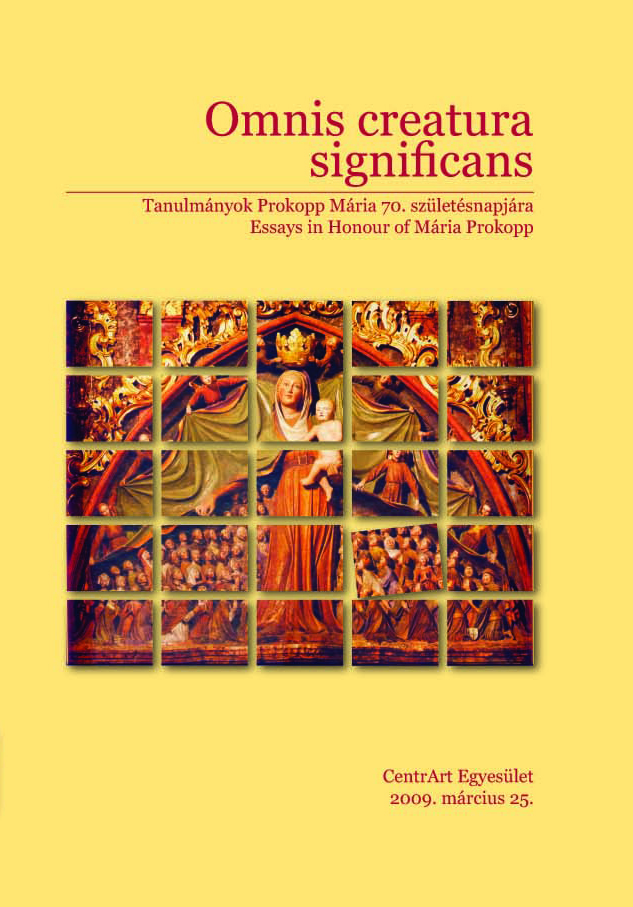Tanulmányok Prokopp Mária 70. születésnapjára / Essays in Honour of Mária Prokopp
Szerkesztőbizottság tagjai / Editorial board : Kerny Terézia, Tüskés Anna
Szerkesztette / Editor in chief : Tüskés Anna
Tördelés és borítóterv / Page setting and cover design : Csirmaz Előd Pál

Tartalom / Contents
Tabula gratulatoria, 14.
Rényi András: Köszöntő – Congratulatory essay, 15.
Kerny Terézia: Köszöntő – Congratulatory essay, 16.
Gassama-Szabó Bernadett: Prokopp Máriának szeretettel – To Mária Prokopp with Love, 18.
Wierdl Zsuzsa: A legkisebb fiú – The Youngest Son, 19.
Gombosi Beatrix: Prokopp Mária születésnapjára – For Mária Prokopp’s Birthday, 20.
Tüskés Anna: Foreword – Előszó, 22.
Martin Pristaš: The Roman Tombstone in the Košice Lapidarium, 23.
Guido Tigler: Il reimpiego e l’imitazione delle steli romane in chiese medievali nell’Italia settentrionale ed in Austria: appunti per un catalogo, 25.
Kiss Etele: Az uralkodó a Paradicsom árnyékában. Gondolatok a Szent Korona abroncsának ikonográfiájáról – The Prince in the Shadow of Paradise: On the Iconography of the Band of the Holy Crown of Hungary, 33.
Nagy Györgyi: Elefántcsontból készült szicíliai-arab doboz az esztergomi Keresztény Múzeumban – Cofanetto siculo-arabo nel Museo Cristiano di Esztergom, 41.
György Ruzsa: Quand la staurotheque byzantine d’Esztergom est-elle arrivée en Hongrie? 47.
Raffay Endre: Az esztergomi királyi palota bejárati homlokzata és az esztergomi stílusrétegek – The Entrance Façade of the Royal Palace of Esztergom and Architectural Styles in Esztergom, 49.
Jankovits Katalin: Árpád-házi Jolánta / Violant temetkezése Vallbona de les Mongesben (Lérida, Katalónia) – Violante de Hungría (Hungría, c. 1216 – Osca / Huesca, 1251) era hija del rey de Hungría Andrea II y Yolanda de Courtenay, 55.
Bóna István: Fototechnikai vizsgálatok a zsámbéki középkori romtemplomban – Photo-technical Examinations in the Medieval Church Ruin at Zsámbék, 61.
Rostás Tibor: Landstrass 13. századi templomai és magyarországi kapcsolataik. Stíluskritikai analízis – Die Kirchen von Landstrass aus dem 13. Jahrhundert und ihre ungarischen Verbindungen. Eine stilkritische Analyse, 65.
Herczeg Renáta: A palágykomoróci református templom – The Reformed Church in Palágykomoróc, 73.
Kerny Terézia: Magyar szent királyok középkori kompozíciói a templomok külső falain – Frescoes of Hungarian Canonized Kings on the OuterWalls of Medieval Churches, 81.
Szabó Tekla: Az italobizánci stílusú falképek jellegzetességei – Characteristics of “Italo-Byzantine” Frescoes, 89.
Fehér Ildikó: Néhány Assisiből származó falkép a Szépművészeti Múzeum gyűjteményében – Some Detached Frescoes from Assisi in the Collection of the Budapest Museum of Fine Arts, 95.
Kristína Markušová: A kassai Szent Mihály kápolna restaurálása – The Restoration of St. Michael’s Chapel in Košice, 101.
Juraj Gembický: The Bell Foundry Workshop of the So-Called Gaal Family in the Spiš region, 107.
Szőke Mátyás – Buzás Gergely – Grósz Zsuzsanna: Konrád mester visegrádi nagy harangja és a középkori iglói harangöntő műhelye – Master Conrad’s Big Bell in Visegrád and the Bell Foundry Workshop in Igló, 111.
Eve Borsook: The Materials and Condition of the Last Judgement Mosaic of Prague Cathedral, 117.
Szakács Béla Zsolt: Mária születése a keszthelyi ferences templomban – The Birth of the Virgin in the Franciscan Church of Keszthely, 123.
Jékely Zsombor: A siklósi volt Ágostonos-templom freskóinak stíluskapcsolatai – The Style of the Frescoes at the Augustinian Church of Siklós, 129.
N. Tóth Ágnes: Hozzászólások a Tízezer vértanú ikonográfiájához. Egy püspök a mártírok körében – Beiträge zur Marter der Zehntausend. Ein Bischof im Kreise der Märtyrer – On the Iconography of the Ten Thousand Martyrs: A Bishop in the Circle of Martyrs, 137.
Rákossy Anna: A sokszorosítás szerepe a későközépkori magyarországi kelyhek készítésében – Die Rolle der Vervielfältigung bei der Anfertigung der spätmittelalterlichen Kelche in Ungarn, 145.
Szabó Zsuzsa: Mária megkoronázása a csíkszentdomokosi oltárképen – Die Krönung Mariae an einem Altarretabel aus Csíkszentdomokos, 153.
Szőke Balázs: Térgörbebordás boltozatok a 16. század elején. A somorjai református templom hajóboltozata – Vaults with Curved Ribs: A Case Study, 159.
Eörsi Anna: A szó elszáll, a kép megmarad? A Rolin-Madonna és a San Marco oltár – Verba Volant-Imagines Manent? The Rolin Madonna and the San Marco Altarpiece, 165.
Vukov Konstantin: Az esztergomi Studiolo falképe és a festett architektúra – Wandbild im Studiolo von Esztergom / Gran und die architektonische Fassung, 171.
Olbert Mariann: A teoretikus Vignola. Vignola első traktatusának, a Regola első kiadásának címlapillusztrációiról – Il Vignola teoretico. Sulle illustrazioni del frontespizio della prima edizione della Regola, il primo trattato di Vignola, 177.
Tátrai Júlia: Protestáns vagy laza erkölcsök? Az öt érzék ábrázolásai a 17. századi holland művészetben – Protestant or Loose Morals? The Five Senses in Seventeenth-Century Dutch Art, 181.
Puskás Bernadett: Feliratos ikonok a munkácsi püspökség 17. századi emlékanyagában – Icônes avec inscriptions dans l’éparchie de Munkács au 17eme siecle, 187.
Szilárdfy Zoltán: Sajátos típusok Árpádházi Szent Erzsébet barokk ikonográfiájában – Particular Types in the Baroque Iconography of Saint Elisabeth of Hungary, 193.
Ridovics Anna: “Az emberi váltságnak kúcsa” – Egy barokk kori Mettercia-ábrázolás ritka ikonográfiai típusáról – The Key to the Redemption of Mankind: About a Rare Baroque Iconographical Type of the Saint Anna Trinity, 199.
Haris Andrea: “et Deo consecrat” – A Mária felajánlás ikonográfiája és a tétszentkúti templom oltárképe – “et Deo consecrat”: The Iconography of Mary’s Offering and the Altarpiece of Tétszentkút, 205.
Terdik Szilveszter: Mária-szimbólumok a balázsfalvi székesegyház ikonosztázán – Symbols of Mary on the Iconostasis of Balázsfalva (Blaj, RO), 213.
Korhecz Papp Zsuzsanna: Paulus Antonius Senser (1716-1758) pécsi festő művei a Bácskában – Paulus Antonius Senser (1716-1758), Maler aus Pécs / Fünfkirchen und seineWerke in der Bačka, 221.
Kelényi György: A szombathelyi püspöki palota – The Bishop’s Palace at Szombathely, 225.
Smohay András: Árpád-házi Szent Erzsébet tiszteletének újkori emlékei Székesfehérvárott – The Modern Monuments of the Cult of St Elisabeth of Hungary at Székesfehérvár, 231.
Basics Beatrix: A nemzeti múlt emlékhelye: a Magyar Nemzeti Múzeum Képtára – The Picture Gallery of the Hungarian National Museum as a Memorial of National History, 237.
Beke Margit: A Pázmáneum, mint épített örökség a XIX-XX. században – The Pazmanaeum as Architectural Heritage in the 19th and 20th Centuries, 243.
Prékopa Ágnes: Túl az időn. Az irodalom és a zene motívumai XIX. századi órák dekorációin – Über die Zeit hinaus. Literatur- und Musikmotive an der Dekoration von Uhren aus dem 19. Jahrhundert, 249.
Komárik Dénes: Hofrichter József ismeretlen zsinagóga-terve – József Hofrichters unbekannter Synagoge-Entwurf, 255.
Szegedy-Maszák Zsuzsanna: Két portré Barabás Miklósné, Susanne Bois de Chesne-ről – Two Portraits of Susanne Bois de Chesne,Wife of Miklós Barabás, 261.
Millisits Máté: A budapesti Szent István-bazilika harangjai és harangjármai – The Bells of Saint Stephen’s Basilica in Budapest, 267.
Papp Júlia: Adatok Beszédes Sándor Albrecht Dürer fametszetes Passió sorozatairól készített fényvéseteihez – Observations on the Heliogravures by Sándor Beszédes of the Little Passion and the Great Passion Series by Albrecht Dürer, 273.
Gassama-Szabó Bernadett: Roskovics Ignác – Egy méltatlanul elfeledett festő legkiemelkedőbb munkái – A Survey of the Most Significant Works of Ignác Roskovics, a Painter Passed into Oblivion, 279.
Székely Miklós: Az 1900-as párizsi világkiállítás magyar építészeti alkotásai – Hungarian Architecture at the 1900 Paris Exhibition, 285.
Tüskés Anna: A Schmidt-cég “pozzói”-nak problémája – The Well-Heads of the Schmidt Company, 291.
Keserü Katalin: Toroczkai Wigand Ede és Kós Károly, avagy a “székely stílus” – Ede Toroczkai Wigand and Károly Kós: The “Szekler Style”, 297.
Dombrovszky Ninette: Ábrahám áldozata (1Móz 22,1-18). A biblikus téma Chagall művészetében – The Sacrifice of Abraham (Gen. 22:1-18): The Biblical Subject in Chagall’s Art, 305.
Ordasi Zsuzsa: Firenze, Via Toscanella. Ottone Rosai, Firenze 20. századi festője – Firenze, Via Toscanella. Ottone Rosai, pittore di Firenze nel Novecento, 309.
Kontsek Ildikó: Prokop Péter festőművész (Kalocsa, 1919 – Budapest, 2003) utolsó hazai évei és hagyatéka – The Last Period and the Bequest of Painter Péter Prokop (1919, Kalocsa – 2003, Budapest), 315.
Nagymihályi Géza: Misztikus Istenszülő ikonok – The Mystical Icons of the Mother of God, 321.
Farkas Zsuzsa: A fénykép a rendszerben – Photograph in the System, 327.
Pál József: “Omnis creatura significans” – “Omnis creatura significans”: The Creation of Symbols, 333.
J. Újváry Zsuzsanna: Árpád-házi Szent Erzsébet tisztelete a kassai polgárok között a közép- és kora újkorban – The Veneration of St Elisabeth of the Árpád-Dynasty among the Citizens of Kassa in the Middle and the Early Modern Ages, 341.
Érszegi Géza: Castellum Stikat – Castellum Stikat: The Career of Péter Poharas in the Hungarian Royal Court, 349.
Sárközy Péter: A budapesti Dante-kódex “kritikai” kiadása – The Facsimile Critical Edition of the Dante-Codex of Budapest, 355.
Kovács Andrea: A középkori magyar sequentionale – The Medieval Hungarian Sequentionale, 359.
Gyulai Éva: “Sua alienaque pignora nutrit” – Szapolyai János király impresája – Sua Alienaque Pignora Nutrit: The Impresa of King John I, 369.
Knapp Éva: Egy XVII. század eleji vers képi hátteréhez – The Visual Background of Two Early 17th-Century Poems of János Rimay, 375.
Probáld Ferenc: Művészet és tudomány határán. Vázlat a földrajzi tájfogalom történetéhez – Between Art and Science: Outline of the Evolution of the Landscape Concept, 383.
Barna Gábor: A “magyaros” Szent Erzsébet – The “Hungarian” St Elisabeth, 387.
Kovács Imre: Megjegyzések Liszt Michelangelo-recepciójához – Notes on Franz Liszt’s Reception of Michelangelo, 393.
Szörényi László: A magyarországi humanizmus-kutatás XX. századi fordulópontjai – The Turning Points of the Research of Humanism in Twentieth-Century Hungary, 401.
Schmidt Péter: A Burgenlandi Apostoli Adminisztráció keletkezése (1918-1922). A Győri Egyházmegyei Levéltár forrásai – Die Entstehung der Apostolischen Administration Burgenland (1918-1922). Das Quellenmaterial des Diözesanarchivs Győr, 407.
Móser Zoltán: Mária nevére – On the Name of Mary, 411.
Wierdl Zsuzsanna: Saint-Germain-des-Prés, Chartres, kontra Esztergom – Saint-Germain-des-Prés, Chartres, vs. Esztergom, 415.
Prokopp Mária életrajza, 417.
Biography of Mária Prokopp, 418.
Prokopp Mária válogatott publikációinak jegyzéke. Összeállította: Vesztróczy Éva – Selected Bibliography of Mária Prokopp. Compiled by Éva Vesztróczy, 419.
Személy- és helységnévmutató – Index, 425.
A kötet szerzői – About the Authors, 441.

